........the shorter lead should be the outer foil - see mundorf site
https://www.mundorf.com/audio/en/shop/Capacitors/Audio_Caps_EVO/MCap_Supreme_Evo_SGO/
https://www.mundorf.com/audio/en/shop/Capacitors/Audio_Caps_EVO/MCap_Supreme_Evo_SGO/
I use a DMM and check the resistance from touching the outer portion of the barrel and either lead.
One lead will have a lower reading, that is the outside of the wrap. It should be AWAY from the positive or toward the negative for a noise rejection install. The few that might be difficult to differentiate are usually very small in diameter.
Big caps are pretty easy. Change the battery in the DMM, ay. 🙂 It's kind of the SOP for me any more if it's been a while.
It's not the perfect way, but it works. I clean the leads and plugs too. It takes 5 seconds to be consistent to a point. Clamp the lead and use a probe for the barrel. Don't use your fingers as clamps.
I just went through a pile myself for a/my Cary SLP-05 and a second V12r I added to the mix.
Have fun.
One lead will have a lower reading, that is the outside of the wrap. It should be AWAY from the positive or toward the negative for a noise rejection install. The few that might be difficult to differentiate are usually very small in diameter.
Big caps are pretty easy. Change the battery in the DMM, ay. 🙂 It's kind of the SOP for me any more if it's been a while.
It's not the perfect way, but it works. I clean the leads and plugs too. It takes 5 seconds to be consistent to a point. Clamp the lead and use a probe for the barrel. Don't use your fingers as clamps.
I just went through a pile myself for a/my Cary SLP-05 and a second V12r I added to the mix.
Have fun.
Attachments
Does this work if the capacitor case is non-conductive? Seems it wouldn't.I use a DMM and check the resistance from touching the outer portion of the barrel and either lead.
One lead will have a lower reading, that is the outside of the wrap. It should be AWAY from the positive or toward the negative for a noise rejection install. The few that might be difficult to differentiate are usually very small in diameter.
Big caps are pretty easy. Change the battery in the DMM, ay. 🙂 It's kind of the SOP for me any more if it's been a while.
It's not the perfect way, but it works. I clean the leads and plugs too. It takes 5 seconds to be consistent to a point. Clamp the lead and use a probe for the barrel. Don't use your fingers as clamps.
I just went through a pile myself for a/my Cary SLP-05 and a second V12r I added to the mix.
Have fun.
No - but it's still usually possible to tell. DMMs with capacitance reading are fairly low cost now. Connect one test-lead to a cap-lead. attach the other lead to a «search plate» - a piece of copper foil or some otherpiece of metal. The outer side will naturally give more capacitance when the search-plate is held near the cap's body.Does this work if the capacitor case is non-conductive? Seems it wouldn't.
Many rectangular caps don't have an inner/outer format. These caps are symmetrical, because they are of stacked-construction: the plates are stacked alternately (interdigitation).
for power supply caps, the Stacked construction MKP caps are usually to be preferred - exampl: DC-Link types.
These have very low ESR and ESL.

![20220429_161747[1].jpg](/community/data/attachments/1008/1008040-2440271cd873cfeac5ff4cb30d81854d.jpg?hash=JEAnHNhzz-)